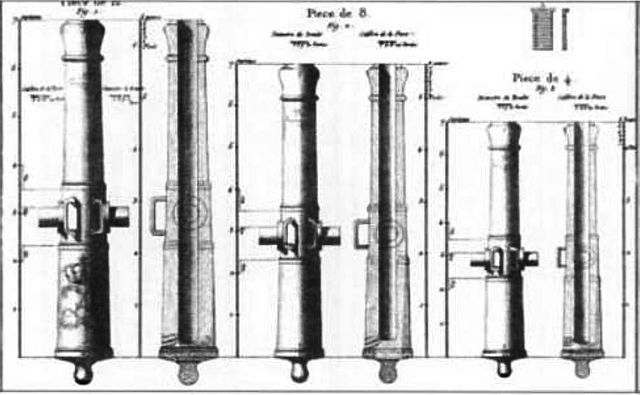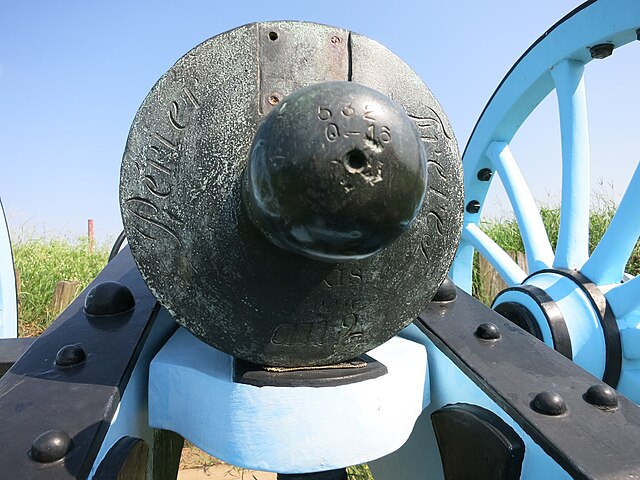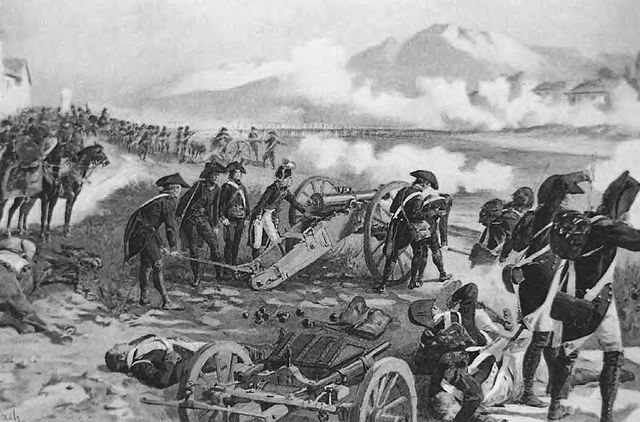The Canon de 4 Gribeauval or 4-pounder was a French cannon and part of the artillery system developed by Jean Baptiste Vaquette de Gribeauval. The Old French pound was 1.079 English pounds, making the weight of shot about 4.3 English pounds. In the Gribeauval era, the 4-pounder was the lightest weight cannon of the French field artillery; the others were the medium Canon de 8 Gribeauval and the heavy Canon de 12 Gribeauval. The Gribeauval system was introduced in 1765 and the guns were first employed during the American Revolutionary War. The most large-scale use of Gribeauval guns occurred during the French Revolutionary Wars and the Napoleonic Wars. At first a pair of 4-pounders were assigned to each infantry battalion and were often called battalion pieces. Later, Emperor Napoleon took the guns away from the infantry units and began to replace the 4-pounder with the 6-pounder, using captured guns as well as newly cast French cannons. However, as the French infantry declined in quality after 1809, the 4-pounders were reintroduced in order to provide direct support for formations of foot soldiers. All Gribeauval cannons were capable of firing canister shot at close-range and round shot at long-range targets. The Gribeauval system supplanted the older Vallière system, was partly replaced by the Year XI system in 1803 and completely superseded by the Valée system in 1829.

The Canon de 4 Gribeauval, was the lightest gun among the Canon de 8 Gribeauval (center) and the Canon de 12 Gribeauval (left).
A 4-pounder Gribeauval cannon is sited in Battery 5 at Chalmette National Battlefield in New Orleans, La.
Close-up shows an inscription: PARIS Nivose An 2 (21 Dec 1793–19 Jan 1794) and Périer Frères (Périer Bros.).
French cannons in action against the Austrians at the Battle of Lodi on 10 May 1796.
The Canon de 8 Gribeauval or 8-pounder was a French cannon and part of the Gribeauval system developed by Jean Baptiste Vaquette de Gribeauval. The Old French pound was 1.07916 English pounds, making the weight of shot about 8.633 English pounds. The 8-pounder was the medium weight cannon of the French field artillery; the others were the light Canon de 4 Gribeauval and the heavy Canon de 12 Gribeauval. Replacing the older Vallière system, the Gribeauval system was introduced in 1765 and the guns were first employed during the American Revolutionary War. The most extensive use of Gribeauval guns was during the French Revolutionary Wars and the Napoleonic Wars. The 8-pounder could be found in divisional reserves, advanced guards or army artillery reserves. Emperor Napoleon began to phase out the 8-pounder by increasing the proportion of 12-pounders in his artillery. The emperor began switching calibers to the handier 6-pounder piece, utilizing captured guns as well as newly designed French cannons. The Year XI system began in 1803, but it only partly replaced the Gribeauval system which was not entirely suppressed until the Valée system was introduced in 1829.

The Canon de 8 Gribeauval, was the intermediate size between the Canon de 12 Gribeauval (left) and the Canon de 4 Gribeauval (right).
Gribeauval
An 8-pounder Gribeauval cannon is sited in Battery 6 at Chalmette National Battlefield in New Orleans, La.
Napoleon Bonaparte's cannons put down an October 1795 attempted coup in Paris. The two cannons in the sketch are almost wheel to wheel; the minimum gap between guns was normally 10 meters.







